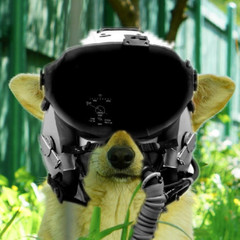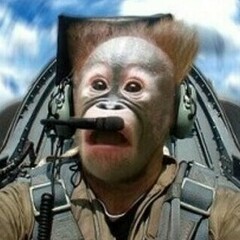-
Posts
228 -
Joined
-
Last visited
About Theodore42
- Birthday April 1
Personal Information
-
Flight Simulators
MSFS 2020
-
Location
Texas
Recent Profile Visitors
The recent visitors block is disabled and is not being shown to other users.
-
A lot of people seem to not be adjusting to the new landing physics so well, but I think it's great. I took the opportunity to learn the "Tennessee Waltz" maneuver - driving up the runway in a side slip on one wheel. I got some cool external shots of the aircraft bouncing around on the runway. It looks pretty realistic to me. At the very end of the video the Mustang bounces a little on one wheel and then it bucks across the runway. Looks just like something you would see in old wartime aviation crash films. Good new technology
-
I read the reason ED modeled the Mosquito's undercarriage physics first is because the Mosquito's gear is really stiff. So now that ED is expanding to more difficult gears to model, there does seem to be a lot of janky-ness with the Mustang's wheel physics now. New features are always like this and they always get polish eventually. As for the issue of stopping, I'm really not feeling it. The tail wheel seems much more prone to lift up and break when it thwacks the ground. But I chalk that up to the new janky wheel physics being too mushy. As far as coming to a complete stop, I'm not feeling inhibited in any way. It does sound like too much messing with the brake axis. Try doing the opposite of what you're attempting to do, just to make sure you understand what's going on. If you get unexpected results they will probably point you in the right direction.
-
TF-51 Cuban 8, Immelmann, and Hammerhead.
-
I'm not sure OPs methodology is sound but I've noticed the EM charts for jets with afterburners seem to indicate the max sustained turn rate is at or near the G limit, not the corner speed.
-
The dogfight was recorded on December 14 on the open beta build so I think it is the current M2000. This is the ace AI, so it flies extremely efficiently but doesn't take into account the advantages of the specific matchup, although it does choose 1 circle vs 2 circle based on the matchup well. Players aren't going to fly quite as efficiently, but even inexperienced (bad) players are going to dodge bullets if they've ever seen someone line up a tracking shot behind them and gotten splattered. And there's a good chance players will dodge snap shots as well. Generally, a thrust to weight ratio fighter is going to be stuck seeking guns solutions in the form of snapshots. To maximize the kill chance for snapshots vs a player, get them as low on energy as possible and then set up a snapshot at about the range I made the kill in the video (imo atm). Any closer and it gets hard to roll the crosshairs over the target. (The M2000 is half the size of an F-14 so it's a lot closer than it looks.) If a player target is far enough away, and low enough on energy, anticipate that they will jink at the snapshot and be ready for it. Winning the snapshot becomes more of a question of how good you are at mechanics in FPSs or MOBAs rather than how well you understand BFM (How good your reactions are). But the timing leading up the moment of the snapshot requires good BFM. From Shaw, Tactics and Maneuvering, paraphrasing from p67-71 [Lag Pursuit Roll]: Use a barrel roll to move from lead pursuit to lag pursuit to prevent an overshoot. [Lag Displacement Roll]: Use a barrel roll to move from lead pursuit to lag pursuit to increase distance. In the video I use the terms a little arbitrarily, and the distinction is kinda arbitrary anyway, but these are some of the most powerful maneuvers you can use in an F-16. Shaw is published by the Navy so it's free to download, or you can buy a hard copy on Amazon, or wherever. The M2000 can't use its turn radius to defeat an F-16 because that blows all the M2000's energy and it takes a lot more time to get that energy back than the Viper. At that range I wasn't risking an overshoot, I would have done a lag pursuit roll and been fine. The ace AI knows that and doesn't try. It is always efficient. Here is what would have happened: When I noticed the M2000 blowing his energy on a turn, I would have mirrored his turn to zero out the Heading Course Angle. Then I would have pitched up and done a barrel roll over him. I would end the roll on the far side of him in lag pursuit. This adds a lot of distance to your flight path and keeps you behind the target, which is going really slow and has no energy. The Viper can add energy much easier, but doesn't have to in that situation, because the Viper still has all the speed it needs vs a target that has just blown all his. The right and left switching is the AI trying to make a one circle fight. Another way to think of it is that he is trying to create flight path separation. The AI did this maneuver against me successfully at 1:11 in the video. You can see him move away from me and then back, creating enough flight path separation for the rolling scissors, neutralizing my advantage. In other words, he put himself onto my turn circle, even though I was behind him, and won by converting my tail chase into a one circle fight. I went out of plane, so it became a rolling scissors rather than a flat scissors, which is the correct counter for the F-16, but he still neutralized my position. IMO the really doom part of the video is at about 2:25 when I'm too close to him and we're doing those barrel rolls around each other. ANY player, no matter how bad, would have made a MESS of that, and ANY player would have a shot at winning there. The MAIN WEAKNESS of the AI is that is completely lacks aggression. At 2:25 it looks really cool for a YouTube video, but the target is really just dancing with me. A player that close would have thought KILL KILL KILL and done something crazy agro. The AI in DCS is great for studying the philosophy of BFM but the AI will never get a sudden KILL insight. Bad players do all the time, and it often works, even at the worst times. !!! DISCLAMER: This is only what I think is right at the moment. I learn by reading Shaw, imitating what I read in DCS, reading Shaw again and probably picking up only ONE thing, going back to DCS and doing and UNDERSTANDING that ONE thing; and then repeat.
-
I started recording my dogfights and saying the BFM that I was doing so I could remember what I was thinking when I played them back. I thought the videos were cool so I uploaded them to youTube and they were kinda popular. But I stopped narrating because as my skill improved there was just too much for me to think about and also speak at the same time. I tried uploading the dogfights to music but that just isn't as popular. So here is a new form of video, I pretty much analyze everything I'm thinking about. It's my first attempt but it's --MOSTLY coherent. (!)
-

An in depth look at engine management in the Mustang
Theodore42 replied to Diesel_Thunder's topic in DCS: P-51D Mustang
Keeping it green is for repositioning or other non-combat missions to maximize engine life. But the Mustang is a weapon of war and weapons break when you use them. IRL this means that the P-51 engine had a lot more maintenance than her GA contemporaries. In DCS it means nothing The hottest the engine gets is during the climb, so your description of the oil temp being pegged to the red line during climb out sounds about right. As long as the needles don't stray INTO the red then you're ok. If left in AUTO this almost never happens, unless you're running max power at very low speeds. Far more likely you will blow your engine overheating the aftercooler rather than overheating the oil or coolant. (there is no temperature gauge for the aftercooler btw) Once you get the hang of being ok with the temps always being a little too close to the red, but never in it; the next issue you will have is that now you suddenly need to be closing your radiator doors because they are making too much drag. If you get into "normal" dogfights, like you see in the movies, you're going to notice the radiator doors are always open, even when you dive into a low yoyo and get going really fast. All that drag! When your mentality gets to this point, leave it in AUTO and instead fly faster and less aggressively. The Mustang is for "boom and zoom" tactics, you boom the target, then you zoom away, up, and sustain that speed as long as possible, because no matter how good your opponent is at climbing the Mustang will have less drag at high speeds. So you always have an advantage when going fast. And if you leave radiator flaps in AUTO while sustaining high speeds, they will always be mostly closed, compounding your advantage. But like graffspee said above, the Mustang's AUTO doesn't transition between those two styles well. If you insist on getting into a knife fight in the Mustang then you can expect the radiator doors to be gaping most of the time. I can't honestly say there aren't opportunities to manually min/max drag in those situations... but in my experience, 99% of players would be better served keeping trimmed up and flying the ball rather than thinking about micromanaging radiator flaps. -
The Viper can out accelerate anything between 300 and 400 knots... Unload to less than 1 G and you go from 300 to 400 in about 2 seconds. Use the Small turn radius at 300 to get geometrically behind the bandit, unload 2 seconds to accelerate... that's the idea behind a low yo-yo btw. You can also out accelerate anything between about 350 and 500 while pulling about 3-5Gs. If you get the hang of unloaded acceleration between 300 and 400 and loaded acceleration between 350 and 500 then you're going to be hard to catch. Also, oblique (climbing) turns = bad; slice (diving) turns = good, especially vs the Hornet. The first step to learning BFM is to understand turning circles. This is just the radius of the turns that you and the target are making. They change depending on your speed and the targets speed and the relationship between those two speeds over time, and the geometric relationship between you and the target. When you're learning just notice that this is happening. The second thing to learn is the jargon for the geometric relationships between you and the target aircraft. The angle between your course and the target aircraft is lead angle and the difference between your course and your target's course, Heading-Course Angle. There are many different names for those two ideas but the concepts are universal. Learn to use your speed to manipulate the radii of your turning circles to control the lead angle and HCA between you and your target. The third step is to understand that you will kill the target and that this is not a dance to look cool. Don't worry, you will automatically look cool when you kill the target. The Fourth step is to study the Basic Fighter Maneuvers, because now you understand the geometry you're trying to manipulate, the acceleration (technique) by which you will do it, and your intention to kill the target. If you skip the first 3 steps you will only be practicing formation flying and will be unable to perceive how to utilize BFM to get the kill.
-

Yak-52 Aresti Aerobatic Sequence PJ Harvey
Theodore42 replied to Theodore42's topic in Screenshots and Videos
Another: -

DCS: Yak-52 Screenshots and Videos (NO DISCUSSION)
Theodore42 replied to Nealius's topic in DCS: Yak-52
-
-
Don't worry about the rudder unless you want to make a kill in the 3/4 inverted pass position (for style points). Read for free from the Navy: Fighter Combat: Tactics and Maneuvering by Shaw. You want chapter 2, which it looks like you've already read; and chapter 4 is what every F-16 nerd should read. It is about 1v1 vs the thrust-to-weight ratio fighter (you) vs low wing-loaded fighters (them). Also, the MiG-21 is a thrust to weight ratio fighter, all be it a different era, but you're gonna want to read chapter 3 for some tips on dealing with other fighters like the F-16. The trick to converting knowledge into kills: You have to want to get the kill. As irrational as it sounds, 99% of the time people jump into a sim 1v1 they end up dancing with the enemy rather than killing them. BFM is basically a dance and if you do it "right" everyone ends up equal. So BFM when you want the kill is about getting an advantage, and you get an advantage by FEELING it, by wanting the kill. Then you have to take what you KNOW is a risk, using BFM, to increase your advantage. I posted a really long and specific list of things to do as a Viper pilot in this thread: And if you have any questions, I DO like talking about how much better the Viper is a dogfighting than anything else! And a lot of other people here do too, don't worry
-

DCS: Yak-52 Screenshots and Videos (NO DISCUSSION)
Theodore42 replied to Nealius's topic in DCS: Yak-52
-

Not DCS, but an F15E in the Dubai Air show, can it really do that???
Theodore42 replied to MichaelJWP15's topic in F-15E
Ok you guys might be disrespecting the F-15E a little too much on the STRIKE EAGLE'S forum!!!! It can't pull it's nose up quite so fast but the engines will still push through any beep-beep, beep-beep like it's nothing: -
Buzz313th started following Theodore42
-
Ya for sure. Keeping the pitch above 12 degrees during landing slows you down a lot. It's so effective that people in this thread are wondering why you can't aerobrake under 140 knots when the Viper is really heavy. 1. The manual (irl) says it's ok to land at the max take off weight. BUT you NEED to aerobrake a LOT to get the Viper stopped while it's really heavy because the brakes aren't that great AND 2. In the DCS Viper, you can't aerobrake long enough to slow down enough to stop before the end of the runway that the irl manual says is long enough to safely operate from THEREFORE Either the Viper flight model is wrong and should allow for the ability to aerobrake down to a slower speed OR there are procedures concerning landing near max weight that we don't know. [EDIT: or we all suck at landing] I've seen a video of an F-16 (Spanish maybe?) Taking off with wing tanks and then immediately landing due to a problem. I couldn't find it when I went looking for it though






